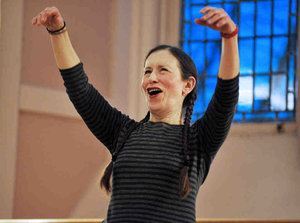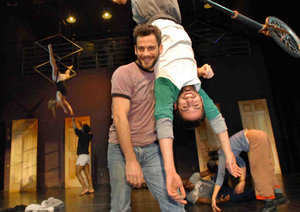
Or is it? I’ve always wondered where that saying comes from because making a great pie does not come easy to everyone. I come from a family of bakers in Fairmount where we were known for our pies. One aunt for her plum crumb, another for her apple, and my mother for her pineapple walnut chiffon pie, a mouthwatering tart if ever there was one. It’s very hard to make a perfect pie until you get the knack – the feel – of making flaky, crispy, rich crusts.
Today’s Philadelphia Inquirer makes this pie article very timely, stating pie will surpass cupcakes in popularity this year.
Throughout the year I make my crusts with butter, oil or non-hydrogenated vegetable shortening, a good one is in Whole Foods, and if you’re used to soft-supermarket vegetable shortening, be forewarned, this stuff is hard and unmalleable.
But I can’t imagine a holiday apple pie without a lard crust. Find pure leaf lard, not a package that says hydrogenated lard. Hydrogenation is what makes fats unhealthy and turns it into trans-fat. That’s why margarine is so much worse for you than a little butter. If you’ve been following the war against trans-fats, you may know that beef lard contains just 40 percent saturated fat, compared with nearly 60 percent for butter and it’s good fat – monounsaturated.
For a good leaf lard, made from the fat around pork organs, take a fall weekend jaunt to Dietrich’s Meats in Krumsville, PA. It’s worth finding because nothing else gives apples more authority than lard. It says winter food.
I didn’t get to Dietrich’s this year but spied a package of beef suet up in a Poconos supermarket and remembering how my grandmother rendered her own snow-white lard from beef kidneys, I snatched it up to experiment with. I rendered it over a medium heat straining the melted fat into a metal bowl where it soon hardened. Once I felt I had enough to use as part of the fat for my crust, I studded the remaining few ounces of suet with nuts, pumpkin and sunflower seeds and hung it out on my patio tree for the birds to winter on. They’re having quite a holiday out there and I enjoy watching them while I bake.
For Thanksgiving, I made a butter and non-hydrogenated vegetable shortening apple pie from a 2009 issue of Bon Appetit that made a French guest burst into tears at first bite. Alarmed, I jumped to her side. “I have never eaten such perfection,” she said and kept repeating it until the last bite.
Still, bakers always want to surpass themselves. So I made the same pie with the following slightly altered crust for Christmas day. I baked one and made another which is sitting unbaked in my freezer for later. I liked the general proportions of the Bon Appetit recipe and stuck close to them, substituting just a portion of my beef lard for the butter for that flavor burst. This is the hardest lard I have ever used and when chilled, it was difficult to cut in, so I grated it on the shave side of my grater and it turned out terrific, giving me the sturdy crust I wanted to travel to family on Christmas day without losing the bottom crust to fruit juices.
This makes a large pie with 4 lbs of apples and serves 12. Make this your once a year holiday crust. If you double it, you can have two disks of dough in the freezer. This makes a good single crust for custard pies as it holds its shape beautifully. My next post will be about fillings.
Butter, Vegetable shortening and Lard Crust
Butter a large 10” glass pie pan (Do not miss this step if you want to cut that first piece out without having it fall apart.)
3 cups unbleached flour
¼ cup sugar
1 ¼ t. salt
1 cup unsalted butter – 2 sticks
¼ cup leaf lard
1/3 cup non-hydrogenated vegetable shortening
6+ TBSP ice water
Plastic wrap
Wax paper
Cut the butter and shortening into small pieces. Grate the lard over them and chill in freezer for a few minutes. In a very large wide bowl, whisk sugar and salt into flour and make a well in the flour. Dump all the shortenings in. Run your hands under the cold-water tap for a few seconds to cool your skin and dig into the flour and fats rubbing them quickly together with your fingertips until they break up into small flour-coated bits. Add the first six TBSP of ice-water and combine until you can gently shape the dough into a ball. Only add additional ice-water bit-by-bit as needed – too much and it will be sticky and yucky.
The dough should be malleable, firm and still slightly dry, but wet enough to roll. When it’s right, you’ll feel it.
Divide into two balls and flatten them, wrapping them in plastic wrap. Yeah, the way you’ve seen Martha Stewart do it. Chill for an hour while you make the filling or freeze till you want it.
Pull out a length of wax paper larger than your pie pan, double it and cut it off the roll. Fold that in half and slide your bottom crust inside for easy rolling. When you’ve it a good inch wider than your pan, slide a cookie sheet under it and stick it in the fridge while you roll out the top crust. Put that one in the fridge while you start handling the bottom crust.
The trick is to keep both crusts cold as possible and work fast. The colder the crust is the easier the wax paper will peel off. Peel back the top section of wax paper, lay it back and flip the crust, lay it flat and peel back the other side. Now you have loosely covered crust and you can peel back one side of the paper and easily slam the dough into the center of your prepared pan, pulling off the rest of the paper. Press the dough into the sides gently. Run the tines of a fork gently around the sides and prick the bottom all over. You may sprinkle a TBSP of graham cracker, vanilla wafer or even plain bread crumbs over the bottom to absorb fruit juices. Fill, place top crust on and seal the edges. Make steam slits or holes, glaze with milk or egg wash, and sprinkle with Sugar in the Raw if you like. Place on a four-sided jelly-roll pan or the fats will melt out and make a mess in your oven. Use the lowest rack and bake at 425° 15 minutes; turn oven down to 375° for about an hour longer. Cool for an hour to let the pie set up. This pie or its leftovers can sit out overnight, covered with a bowl. Refrigerating it hardens the crust and you’ll have to let it come to room temp or reheat it to serve again.
 SHARON GEKOSKI-KIMMEL / Staff Photographer
SHARON GEKOSKI-KIMMEL / Staff Photographer
